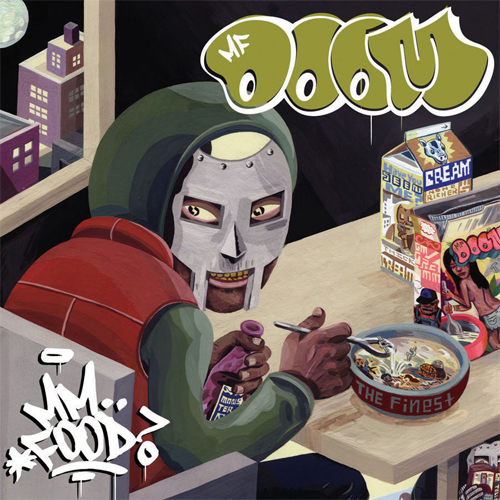I hope you’re hungary. It’s MM.. Food!

MM.. Food
That’s right. The masked, metal fingered villain, MF DOOM is back. Remember, all caps when you spell the name. It’s been five years since DOOM released an album under the MF DOOM moniker. The previous MF DOOM album, Operation: Doomsday, is an absolute DOOM classic. Time has passed though, and since releasing Operation: Doomsday in 1999, DOOM has released a King Geedorah album, two Viktor Vaughn albums, and Madvillainy with producer Madlib.
Separated by only three months from the release of Venomous Villain, MM.. Food is far from the women killing and murder of Viktor Vaughn’s tastes. Instead MM.. Food is DOOM back in the same character from Operation: Doomsday. Prior to MM.. Food, I’d written about how the character of MF DOOM is that of a misunderstood “villain”. In our mind, helped painted by the tone of the album as well as the mask, MF DOOM can come off as just that… a villain. Under closer examination, however, it is clear that MF DOOM is misunderstood. On Operation: Doomsday I made the case for DOOM’s modus operandi being the loss of his brother Subroc. DOOM revisits these same themes as before in MM.. Food.

On tracks like “Kon Karne”, DOOM depicts what life was like when his brother was around. DOOM even dedicates the track to his brother: “I dedicate this mix to Subroc the Hip Hop Hendrix”. The loss of Subroc in 1993 really damn near killed DOOM. The sudden loss of his brother, the problems with the release of KMD’s Black Bastards–life wasn’t easy for DOOM them. He found himself homeless and living on the streets. The creation of MF DOOM probably saved his life–we know what it did for his music career. Following the verses on “Deep Fried Frenz”, DOOM’s background and motivation is explored in typical DOOM fashion–with samples.
After a sample from the 1970 movie Watermelon Man, the line: “Negro humor always escaped me” is sampled. This can be seen again as the misunderstand people have with DOOM. They don’t get him. They don’t get his humor. The samples continue illustrating how feared DOOM is, how many foes he has, and how he’s the “most dangerous man in the world”. The samples continue to tell a story of a DOOM alone, “to peruse his forbidden experiments”, when an explosion leaves DOOM’s face disfigured. This can be takes literally as meaning for DOOM to wear his mask, or it can be looked at in relation to Subroc’s death. DJ Subroc was hit by a car when he was only 20–that is the explosion. DOOM became “bitter, angry, vengeful” and travel the world seeking a cure. This relates to that period of time between 1993 when Subroc died, to 1999 when Operation: Doomsday put DOOM back on the hip hop map. This idea continues throughout the album.

On “Fig Leaf Bi-Carbonate” the samples return, nothing that “as years passed he became more bitter and angry and burning with vengeance against the world”. With the help of his lyrics, his flow and some stylish armor MF DOOM returned and rose again, with aspirations to become the world’s greatest rapper. This is quite the interesting approach when it comes to discussing who MF DOOM really is. The samples in MM.. Food, help to reinforce the theory I preposed in previous DOOM discussion regarding the misunderstood nature of MF DOOM. He can be interpreted as someone dangerous and evil, when really he’s just trying to survive after the loss of his brother.
MM.. Food is easily one of MF DOOM’s most lyrical showings. DOOM raps of subject matter unorthodox in hip hop. DOOM raps about friendship on “Deep Fried Frenz”, his appeal to “freaks and pencil neck geeks” in “Kon Queso”, masturbation in “Kookies” and how rapping about crimes can be self-incrimination on “Rapp Snitch Knishes” with Mr. Fantastik. DOOM does all this while making the most impressive food metaphors. On “Fillet-O-Rapper” the food beats are used to reference the instrumentals DOOM spits over. “Kon Queso” or ‘with cheese’, as it translates in Spanish, is used to allude to money. Edible wrappers is used to describe emcees DOOM trounces with his lyrical skill. “Kookies” refers to the literal cookies as well as the HTTP variety in a track about masturbation and internet pornography. The metaphors are nearly endless. None seeming corny or our of place. This is pure brilliance of MM.. Food.

Is it better than Operation: Doomsday? That’s hard to say. It’s a great addition to the MF DOOM moniker in more ways than one, that is for sure. This would be DOOM’s third and last album of 2004.



















